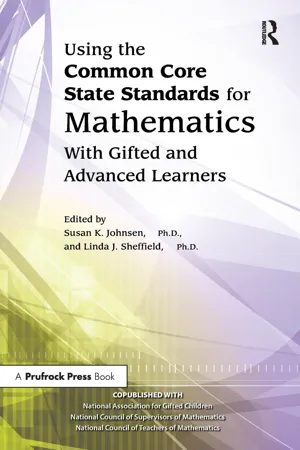
Using the Common Core State Standards for Mathematics With Gifted and Advanced Learners
- 136 pages
- English
- ePUB (mobile friendly)
- Available on iOS & Android
Using the Common Core State Standards for Mathematics With Gifted and Advanced Learners
About This Book
Using the Common Core State Standards for Mathematics With Gifted and Advanced Learners provides teachers and administrators examples and strategies to implement the new Common Core State Standards (CCSS) with advanced learners at all stages of development in K-12 schools. The book describes—and demonstrates with specific examples from the CCSS—what effective differentiated activities in mathematics look like for top learners. It shares how educators can provide rigor within the new standards to allow students to demonstrate higher level thinking, reasoning, problem solving, passion, and inventiveness in mathematics. By doing so, students will develop the skills, habits of mind, and attitudes toward learning needed to reach high levels of competency and creative production in mathematics fields.
Frequently asked questions
Information
Differentiating the Common Core State Standards for Gifted and Advanced Students
- Provide pathways with appropriate pacing of the CCSS for gifted learners. Some of the CCSS address higher level skills and concepts that should receive focus throughout the years of schooling, such as a major emphasis on reasoning and sense-making. However, there are also discrete skills that may be clustered across grade levels and compressed around higher level skills and concepts for more efficient mastery by gifted students. Teachers might use preassessments in determining which students require more accelerated pacing. For example, within the CCSS domain of Measurement and Data, some students in first grade might be estimating lengths in standard units, while others might be solving problems involving measurement and estimation ofliquid, volumes, and/or masses of objects (grade 3) or converting like measurement units within a given measurement system (grade 5).
- Provide examples of differentiated task demands to address specific standards. Standards like problem solving in mathematics lend themselves to differentiated interpretation through demonstrating what a typical learner on grade level might be able to do at a given stage of development versus what a gifted learner might be able to do. The differentiated examples should show greater complexity and creativity using a more advanced curriculum base. In mathematics, whereas typical learners might solve multistep word problems using a variety of models and strategies throughout grades K-12, gifted learners might pose and solve new, related problems of their own at an earlier stage of development. Other degrees of differentiation may take place by adding complexity to the task and using enrichment techniques that address student needs and district demographics, such as using mathematical equations and modeling to solve community problems.
- Create in terdisciplinary product demands to elevate learning for gifted students and to efficiently address multiple standards at once. Because English language arts and mathematics standards can be grouped together in application, much of the project work that gifted educators might already use could be revised to connect to the new CCSS and to show how multiple standards could be addressed across content areas. For example, research projects could be designed that address the research standard in English language arts and the data representation standard in mathematics by (a) delineating a product demand for research on an issue, (b) asking researchable questions that require quantitative approaches, (c) using multiple sources to answer them, (d) collecting data, (e) interpreting data (e.g., by creating a scatterplot and deciding if there is a line of best fit and describing the related variables), and then (f) representing findings in tables, graphs, and other visual displays that are explained in text and presented to an audience with implications for a plan of action. Such a project might be possible for the gifted learner at an earlier grade than for a typical learner.
The Common Core State Standards for Mathematical Practice
- Make sense of problems and persevere in solving them.
- Reason abstractly and quantitatively.
- Construct viable arguments and critique the reasoning of others.
- Model with mathematics.
- Use appropriate tools strategically.
- Attend to precision.
- Look for and make use of structure.
- Look for and express regularity in repeated reasoning.
Developing Innovative and Creative Mathematicians
- Relate the problem to other problems that you have solved. How is this similar to other mathematical ideas that you have seen? How is it different?
- Investigate the problem. Think deeply and ask quest...
Table of contents
- Cover
- Half Title
- Title Page
- Copyright Page
- Table of Contents
- Foreword
- Preface
- Acknowledgments
- Introduction
- The Common Core State Standards
- Rationale for the Work
- Alignment to 21st Century Skills
- Research Support for the Effort
- Differentiating the Common Core State Standards for Gifted and Advanced Students
- Linking Mathematics and English Language Arts Standards
- Differentiating Assessments to Encourage Higher Level Reasoning and Creativity
- Talent Trajectory: Creating Pathways to Excellence in Mathematics
- Implementing the Common Core State Standards With Various Program Models in Gifted Education
- Alignment of the Common Core State Standards With the Gifted Education Programming Standards
- Implications for Professional Learning When Implementing the Common Core State Standards
- Collaboration With General and Special Education
- A Possible Timeline for Implementing the Common Core State Standards Locally
- Resources to Assist With the Implementation Process
- References
- Appendix A: Definitions of Key Terms
- Appendix B: Evidence-Based Practices in Gifted Education
- Appendix C: Annotated References on Mathematical Creativity and Giftedness
- Appendix D: Additional Mathematics Resources
- About the Editors
- About the Contributors
- About the Copublishers